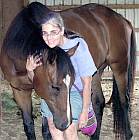Craniosacral Work with Horses
Simply stated, craniosacral work is a complementary and alternative body work practice which uses extremely light finger pressure to assist the animal in the release of stored tension.
History
Craniosacral work arose from the science of osteopathy, and was introduced to the world in the 1930s by an American osteopath and visionary called William Sutherland. He observed that the skull bones are not truly fused and permit slight motion independent of breathing and heart rate. This motion, present in all tissues of the body is called the “cranial wave”. Another way of looking at the cranial wave is from an energy perspective. Our bodies have an energetic or bioelectric field also called “Chi” in the Chinese medicine tradition. When body tissues are subjected to stress or trauma, either physical or emotional, the movement of the cranial wave can be disrupted resulting in imbalance or disease.
What Does a Craniosacral Practitioner Actually Do?
Under usual, healthy conditions the cranial wave rhythm moves between 8 - 14 cycles per minute. The measurable amplitude of the cranial wave or rhythm is between 40 microns to 1.5mm in movement, which is too small to be seen. In a meditative state it can be palpated. Practitioners combine light finger pressure with use of the inner eye and inner ear. Once the restrictions are located, the craniosacral practitioner palpates the cranial wave to assist the animal's body in releasing the tension of the stored injury or trauma. This action is never forced; it is a gentle process of allowing the body to return to a healthy and balanced rhythm. The body has an amazing capacity to heal itself. When animals are in balance emotionally and physically, they are healthy, and equanimity is restored.
What about the Science?
There are few published case controlled research studies on the effectiveness
of craniosacral work on particular medical problems of individuals.
Those that are available suggest that the craniosacral technique can be
effective in alleviating the conditions studied. For example, a 2006 report
on the use of craniosacral therapy for tension headaches demonstrated that
this technique leads to superior pain reduction compared to controls.
(see
http://www.nccam.nih.gov/health/providers/digest/pain-science/headaches).
My personal experience with craniosacral therapy is that it provided relief for my chronic back pain and provided gait improvement for my horse. This led me to study the technique, and to be trained to provide it to horses. We see that equine craniosacral work may provide relief for emotional and behavioral problems, stall walking, cribbing, head, spine, and other injuries, head shaking, TMJ dysfunction, facial nerve paralysis, tinnitus, sinus problems, blocked tear ducts, lameness, colic, tying up, birth traumas, castration, and sacroiliac problems. It is indeed a complementary technique for horses, to be used in conjunction with allopathic veterinary techniques, and when used in this way may provide considerable relief for a variety of conditions.
Additional Information and Craniosacral Practitioners
Milne Institute -
http://milneinstitute.com/whatis.html
Upledger Institute -
http://www.upledger.com/aboutUs.asp
The Cranio Connection -
http://tracyvroom.com/aboutus.html
Equine Craniosacral Workshops -
http://www.equinecraniosacral.com

